Gibbon
Hylobatidae
Found in dense jungles and tropical forests!
Advertisement
Gibbon Scientific Classification
- Kingdom
- Animalia
- Phylum
- Chordata
- Class
- Mammalia
- Order
- Primates
- Family
- Hylobatidae
- Genus
- Hylobates
- Scientific Name
- Hylobatidae
Read our Complete Guide to Classification of Animals.
Gibbon Conservation Status
Gibbon Facts
- Main Prey
- Fruit, Eggs, Insects
- Habitat
- Dense forest and jungle
- Predators
- Leopards, Snakes, Birds Of Prey
- Diet
- Omnivore
- Average Litter Size
- 1
View all of the Gibbon images!
“The fastest-moving tree-dwelling mammal”
Gibbons are tree-dwelling apes that live in Asia and Indonesia. Also known as lesser apes as distinct from great apes, gibbons are quick and agile, brachiating through the treetops at speeds up to 35 miles per hour (56 kph). There are 18 distinct species of this arboreal, or tree-dwelling, mammal, including white-handed, slamang, and lar gibbons. The majority of gibbon species are endangered, and some are critically endangered.
Incredible Gibbon Facts!
- Depending on gender and species, gibbons weigh 6-9kg.
- They live up to 25 years
- Gibbons have extra-long arms and powerful legs for swinging and leaping from tree to tree
- Gibbons are better at walking on two feet than any other ape or monkey
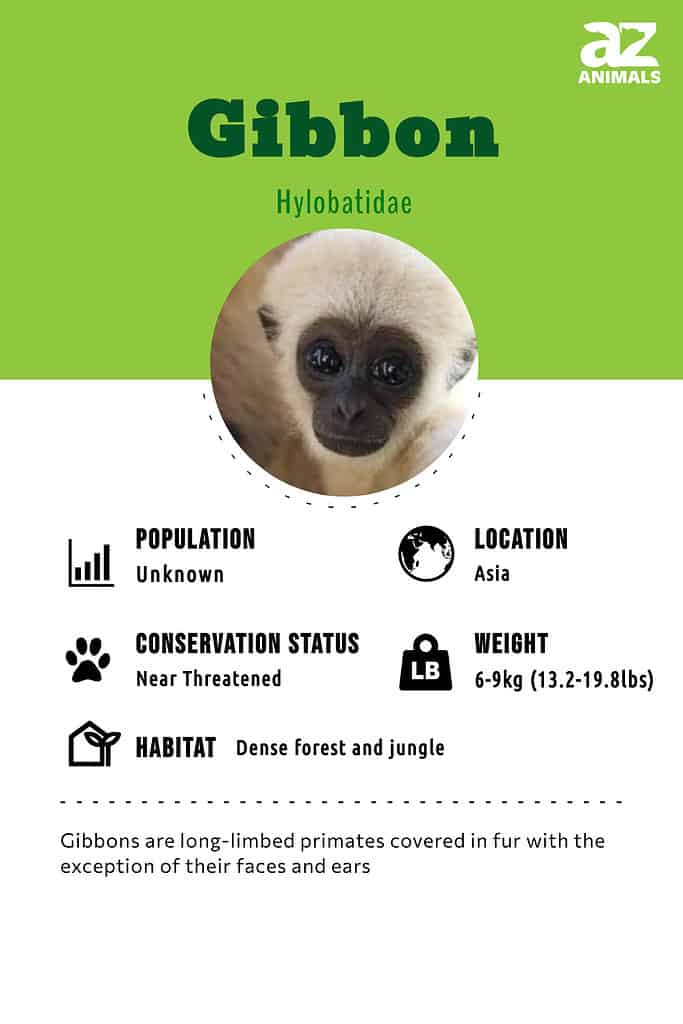
Scientific Name
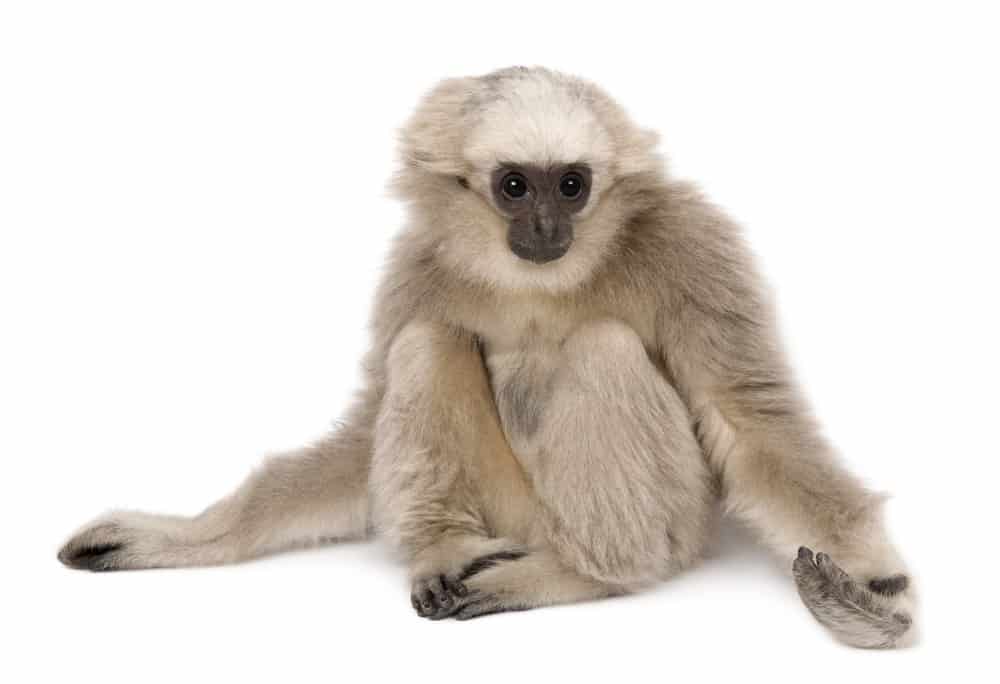
The Hylobatid family, or gibbons is divided into four genera based on the numbers of their diploid chormosomes
©Eric Isselee/Shutterstock.com
The scientific name for gibbon is Hylobatidae. The Hylobatidae ape family contains the genera Hylobates, Hoolock, Nomascus, and Symphalangus.
Dwarf gibbons, whose scientific name is Hylobates, includes the species Hylobates lar, Bornean white-bearded, Agile, Mueller’s, Silvery, Pleated, Kloss’s gibbon.
Hoolock includes the species Western hoolock, Eastern hoolock and Skywalker hoolock gibbon.
The species of crested gibbons, whose scientific name is Nomascus, consists of the Northern buff-cheeked, Black-crested, Eastern black-crested, Hainan black-crested, Northern white-cheeked, Southern white-cheeked, and Yellow-cheeked gibbon.
The Symphalangus genus contains one species, siamang gibbons.
Evolution and Classification
Along with the Hominidae, the Hylobatidae, or gibbons form part of the larger ape family, Hominoidea. However, they are comparatively smaller compared to their larger cousins, and prefer to live in smaller families. Like other apes, gibbons adhere to a somewhat omnivorous diet consisting of fruit, leaves, and grubs. However, they mostly build nests and prefer an arboreal lifestyle compared to several larger apes.
Palaeontologists believe that apes first diverged to form a distinct group about 25 million years ago. Seven million years later, gibbons separated to form their own unique family.
Appearance
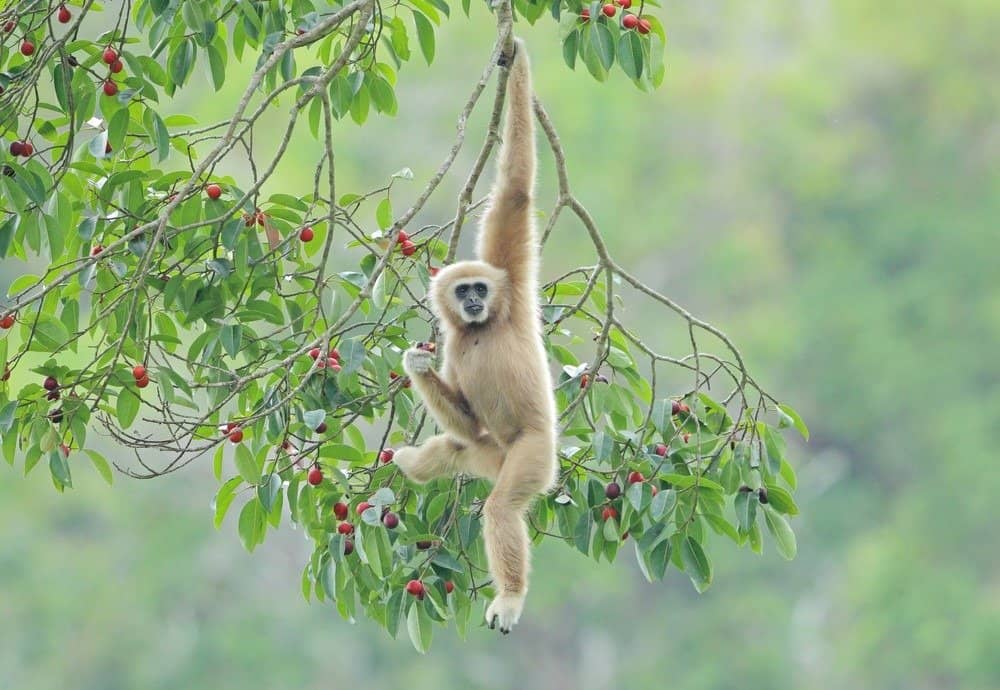
Gibbons have longer arms than usual and specialized wrist joints
©teekayu/Shutterstock.com
These are light, agile apes. Their height ranges from 15 to 36 inches (40 to 90 cm), depending on their species. The largest gibbons, the siamang, are about half the height of their human counterparts. All species have small heads and smooth, apelike faces framed with fur. Just like the great apes and unlike monkeys, they do not have tails.
One of their most noticeable features is their uncommonly long arms, which they use to brachiate through the canopies of trees that serve as their habitat. When these apes walk upright, they hold their arms up by their heads to keep their balance.
These animals have specialized wrist joints that allow them to move their hands from side to side as well as back to front. This promotes fast, efficient progress from branch to branch.
The hands and feet of these lesser apes are elongated. Each hand has a deep cleft that helps them grip strongly onto branches. The siamang gibbon, which is among the largest types of these apes, has two toes on each foot that are permanently fused together.
Their fur can be any color of brown or black, sometimes mixed with white. Their faces, feet and hands often have contrasting markings, as in the Bornean white-bearded or yellow-cheeked species.
Types
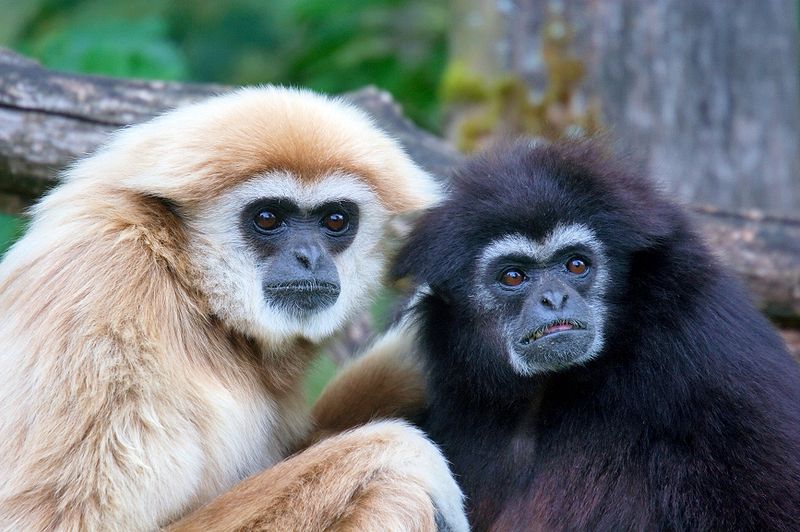
Gibbons are divided into four genera based on the number of diploid chromosomes they have
There are 20 species of gibbon each distributed among four genera. Each genus has a different number of diploid chromosomes, with Hoolock having the least while Symphalangus has the most, 52 chromosomes.
Genus Hoolock: (38 diploid chromosomes)
- Eastern hoolock gibbon, H. leuconedys: Found in Yunnan, China, these primates are mainly frugivorous with figs constituting the majority of their diet. They also enjoy pilfered birds’ eggs, insects, and invertebrates.
- Western hoolock gibbon, H. hoolock: Found in India and Bangladesh, these gibbons are known for their habit of performing duets. They play a key role in seed dispersal.
- Skywalker hoolock gibbon, H. tianxing: Found in Myanmar and China, these primates prefer to sleep in trees’ highest branches. They rarely use the same sleeping quarters two nights in a row.
Genus Hylobates: dwarf gibbons (44 diploid chromosomes)
- Agile gibbon or black-handed gibbon, H. agilis: This primate can be recognized by its dark or red-brown fur, and tufts of white fur on its cheeks and brow.
- Bornean white-bearded gibbon, H. albibarbis: Recognizable by brown or gray fur and a white beard, this gibbon is smaller-sized compared to others. Members of the species live in small groups comprising of family members.
Behavior

All gibbon species are vocal and are known for their musical voices which can be heard over great distances
These lesser apes spend the greater part of their lives aloft in the rainforest canopy. Their long reach and powerful legs make them the world’s greatest brachiators. They can travel quickly, spanning distances of up to 50 feet in a single leap. Occasionally, they will miss a branch or misjudge the distance between trees, and this often results in broken bones
They venture to the forest floor only occasionally. Perhaps they need to look for food or flee from another animal in the treetops. When they are on the ground, these lesser apes often travel on two feet, holding their arms above their heads to stay upright.
All the gibbon species are vocal. Their voices are musical and can travel considerable distances. They use sound to locate other gibbons, warn away intruders and woo their mates. The wooing song, often a duet with the intended mate, is known as the great call.
Siamang gibbons and other species have uniquely developed throat sacs. When the animal inhales, filling the throat sac with air, it amplifies its call through the tropical forest, helping locate other apes, mark territorial boundaries or join in a mating duet. The largest species, the siamang, has a loud voice that travels up to two miles.
In general, these primates mate for life. They live in small, nuclear families made up of a mated pair and one juvenile offspring. Although they sleep in the trees, these animals do not build nests like other apes. Once the young one matures, it ventures out to form its own family group.
Habitat
These animals inhabit the rainforests of Southeast Asia in these countries:
- Bangladesh
- Borneo
- Cambodia
- China
- India
- Indonesia
- Java
- Laos
- Malaysia
- Myanmar
- Sumatra
- Thailand
- Vietnam
These arboreal animals need a dense forest canopy that provides food, shelter, and a means of transportation. Various species live in different regions such as mountains or valleys, but they all share a preference for treetop habitats.
Diet
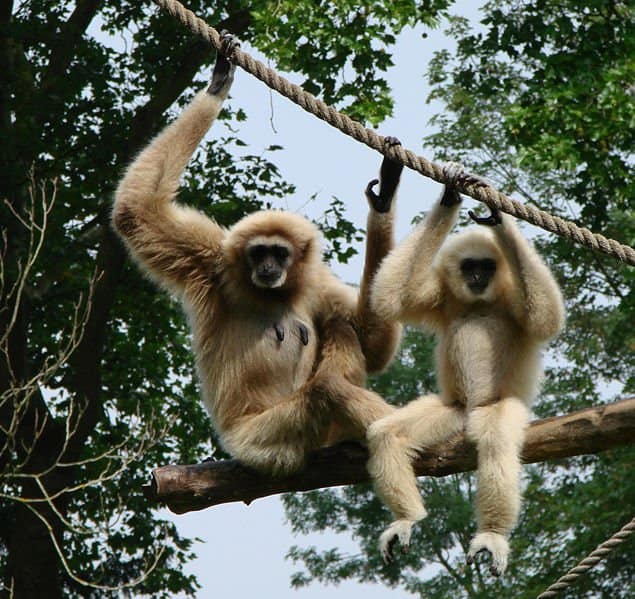
Gibbons eat a rather varied diet composed of fruit, bird eggs, insects, and small creatures
©Vassil – Public Domain
These animals mostly eat fruit and vegetation that are available in the rainforest canopy. They are omnivores, however, so they do eat meat occasionally such as insects, bird eggs, and small animals.
Predators and Threats
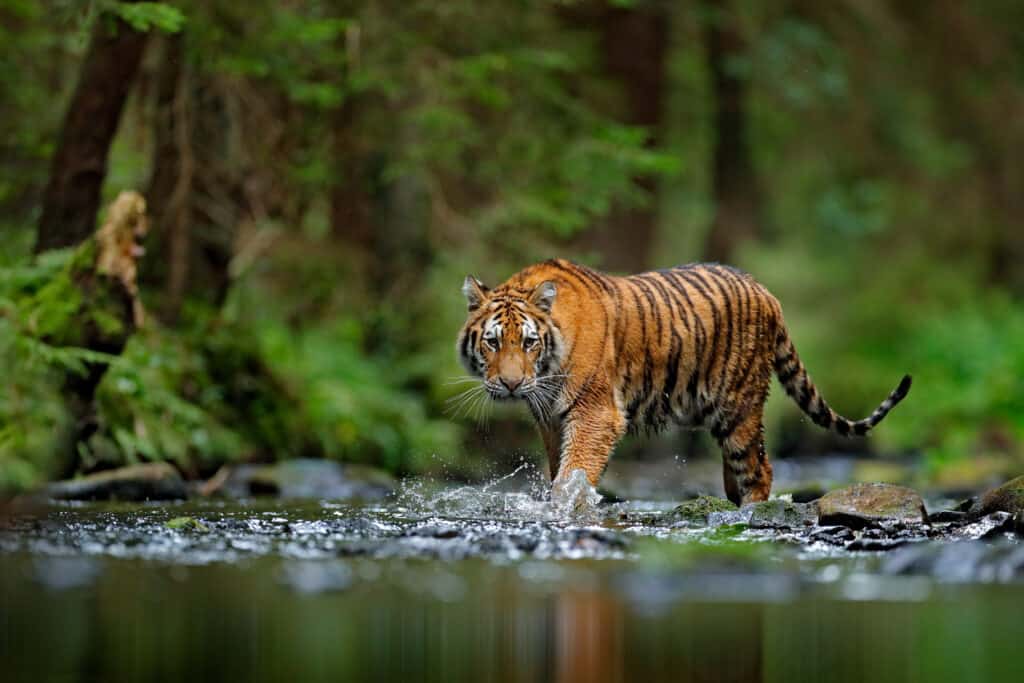
Predators such as tigers consider gibbons a tasty menu item
©Ondrej Prosicky/Shutterstock.com
Large cats native to Southeast Asia, such as clouded leopards and tigers, prey on these lesser apes. Big snakes and eagles also pose a threat to these arboreal apes. One significant study of Maroon Langur monkeys in Borneo showed that white-bearded gibbons made warning calls to alert their own species as well as other animals like the monkeys when predators were nearby, giving them the chance to seek safety.
Humans hunt these animals in the wild to sell to zoos. People in some cultures purchase parts of the animals for healing or eating.
The biggest threat by far, however, is human encroachment on the rainforests that they call home. As civilization claims more and more of these forests, these animals have less food and rapidly shrinking habitats, which is the primary reason so many of the species are endangered.
Reproduction, Babies, and Lifespan
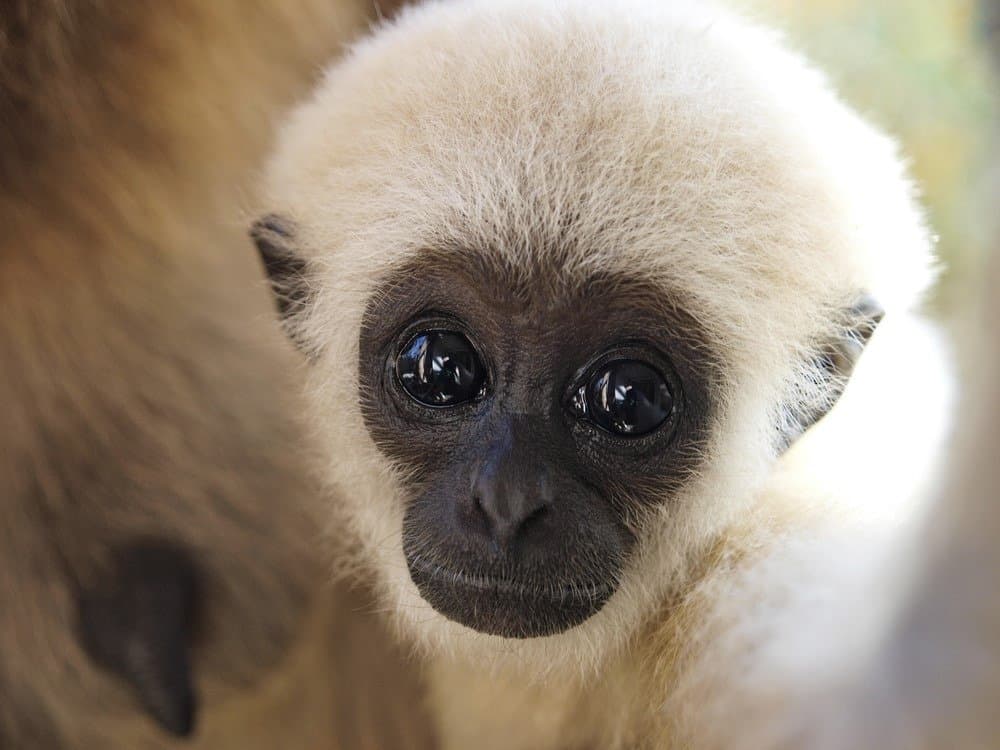
Both male and female gibbons provide parental care to their young
©Simia Attentive/Shutterstock.com
The female gives birth to a single offspring at a time. They may have as many as six babies over the course of their breeding period. Females in the wild reach sexual maturity around eight years of age while males mature a bit later, around 10 years old. These arboreal mammals take a single mate at a time, but they may change partners once their offspring have grown up.
Female pregnancy lasts six and a half months. Once she gives birth, both parents care for the baby until it is old enough to leave home.
On average, these animals in their natural habitat live approximately 30-35 years. Those in captivity tend to live longer, up to 50 years. The longest-lived individual on record, a Mueller’s gibbon named Nippy at New Zealand’s Wellington Zoo, died at age 60.
Population
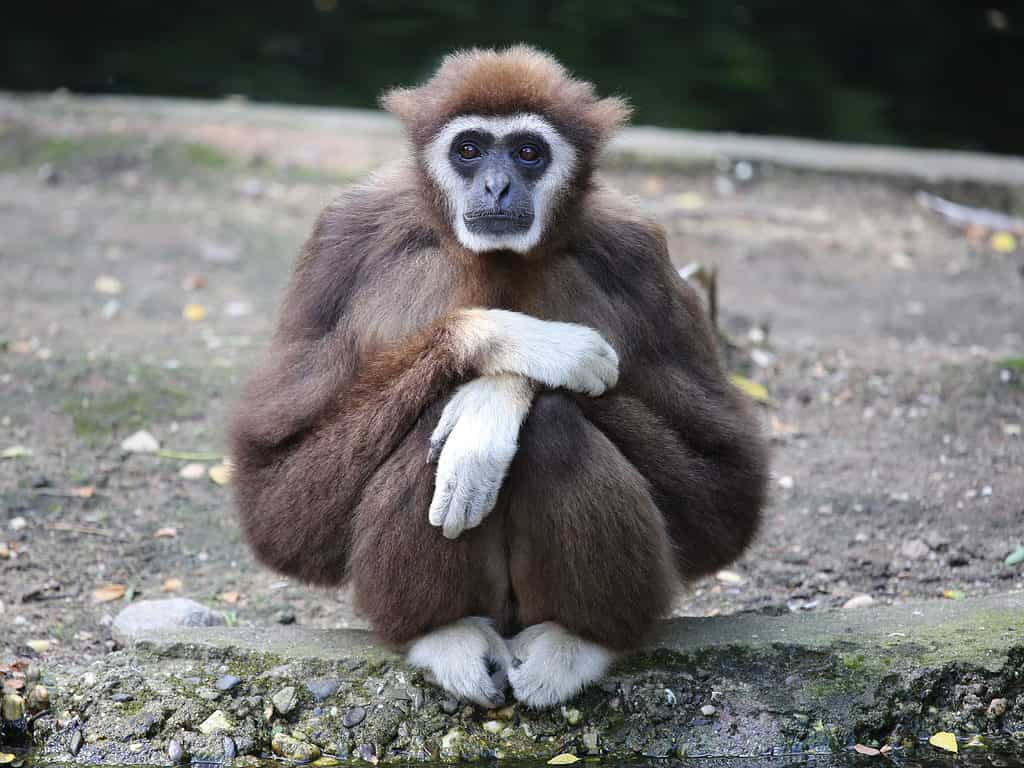
Gibbon populations are declining regardless of the species
©Edwin Butter/Shutterstock.com
All gibbon species are dwindling. The majority of the 18 species are in danger of extinction. In fact, less than 25 Hainan crested gibbons of the Nomascus genus remain, making this species the most critically endangered primate on earth. Other types that are critically endangered also belong to the Nomascus genus, including:
- Black-crested –
- Northern white-cheeked –
- Cao-Vit gibbon
Those species with endangered status are:
• Western hoolock
• Agile
• Bornean white-bearded
• Kloss’s
• Lar
• Silvery
• Mueller’s Bornean
• Pileated
• Abbott’s gray
• Northern gray
• Yellow-cheeked
• Southern white-cheeked
• Siamang
The eastern hoolock gibbon is vulnerable but not yet endangered. Skywalker hoolock and northern yellow-cheeked gibbons require further study to determine their status.
Gibbons in the Zoo

Gibbons are a regular fixture at several US zoos
©Vassil – Public Domain
Many zoos in major US cities have these animals on exhibit. Some of the species you can see in these zoos include the lar, the siamang, and the white-cheeked gibbon. Other types of these tree-dwellers in zoos are the Javan gibbon, the eastern hoolock, and the pileated gibbon.
In Canada, the Toronto Zoo has white-handed gibbons. A gray female gibbon at the Assiniboine Zoo in Winnipeg lived to be 50 years old. Now, the zoo is home to a family of white-handed gibbons. Many other zoos throughout Canada have gibbons too.
In fact, zoos throughout the world have different gibbon species. The most common in are the siamang, the white-cheeked and the lar gibbons.
Complete Species List
Genus Hoolock: (38 diploid chromosomes)
- Eastern hoolock gibbon, H. leuconedys
- Western hoolock gibbon, H. hoolock
- Skywalker hoolock gibbon, H. tianxing
Genus Hylobates: dwarf gibbons (44 diploid chromosomes)
- Agile gibbon or black-handed gibbon, H. agilis
- Bornean white-bearded gibbon, H. albibarbis
- Eastern grey gibbon or northern grey gibbon, H. funereus
- Lar gibbon or white-handed gibbon, H. lar
- Kloss’s gibbon, Mentawai gibbon or bilou, H. klossii
- Müller’s gibbon or southern grey gibbon, H. muelleri
- Pileated gibbon or capped gibbon, H. pileatus
- Silvery gibbon, H. moloch
- Western grey gibbon or Abbott’s grey gibbon, H. abbott
Genus Symphalangus (52 diploid chromosomes)
- Siamang, S. syndactylus
Genus Nomascus: crested gibbons (50 diploid chromosomes)
- Concolor or black crested gibbon, N. concolor
- Eastern black crested gibbon or Cao Vit black crested gibbon, N. nasutus
- Hainan black crested gibbon, N. hainanus
- Northern buffed-cheeked gibbon, N. annamensis
- Northern white-cheeked gibbon, N. leucogenys
- Southern white-cheeked gibbon, N. siki
- Yellow-cheeked gibbon, N. gabriellae
Gibbon FAQs (Frequently Asked Questions)
What is a gibbon?
A gibbon is a lesser ape that lives in Southeast Asia. It spends its life in the rainforest canopies and swings from tree to tree. Its extra-long arms and powerful legs make it the fastest tree-dwelling mammal.
What are the smallest and the largest types of gibbons?
The smallest species is the lar gibbon. It is one of the seven dwarf species, and adults are about eight inches tall and weigh 12-13 pounds. The largest gibbon is the siamang, which grows up to three feet tall and weighs up to 26 pounds.
Are gibbons monkeys?
Gibbons are not monkeys. They do not have tails as monkeys do. Gibbons are more closely related to the great apes of Africa and Asia, but they are called lesser apes.
Are gibbons dangerous?
Gibbons normally do not pose a threat to humans. Like any animal in the wild, however, they become aggressive when they believe their family or their territory is in danger. They use their booming voices to warn off intruders.
Where do gibbons live?
Gibbons live in countries throughout Southeast Asia. Their natural habitat is the rain forest. They also live in zoos throughout the world.
Why do gibbons have long arms?
With arms half again as long as their legs, gibbons are designed to brachiate, which means swinging through the treetops. They have special wrist joints that allow rotation so they can easily twist and turn.
How many gibbons are there left on earth?
Although researchers haven’t counted all of the species of gibbons on earth, they have come up with approximate numbers for the most endangered groups:
• Hainan crested, 25
• Cao-Vit crested, 100
• Black-crested, less than 2,000
• Silvery, less than 4,500
• Kloss’s, less than 25,000
• Pileated, less than 47,000
• Western hoolock, less than 110,000
• Eastern hoolock, less than 370,000
Have they discovered any new species?
The Skywalker hoolock gibbon is a recent discovery. The first official announcement of this new gibbon came out in the American Journal of Primatology in 2017. The name Skywalker comes from Star Wars lore, but it also is appropriate to an animal that spends most of its life in the treetops.
Why do gibbons live longer in zoos than in the wild?
In the wild, gibbons have to compete for food and mates. They are at risk from predators. They can hurt themselves if they fall from the trees and must recover without medical care. It’s different in the zoo. Regular feedings and a balanced diet promote good health. They often have a mate provided for them, and they are not in danger from any predators. Even though they live in captivity, they tend to stay healthier and live longer.
What will happen to gibbons when the rain forests are gone?
Gibbons’ lives and healthy rain forests are inextricably linked. As the forests become smaller due to human activities, the number of gibbons also shrinks. However, the extinction of this unique, irreplaceable animal is not inevitable. Conservation groups like the Gibbon Conservation Center and Gibbon Conservation Alliance are working to save gibbon habitat and provide safe homes for gibbons in captivity.
Are Gibbons herbivores, carnivores, or omnivores?
Gibbons are Omnivores, meaning they eat both plants and other animals.
What Kingdom do Gibbons belong to?
Gibbons belong to the Kingdom Animalia.
What phylum do Gibbons belong to?
Gibbons belong to the phylum Chordata.
What class do Gibbons belong to?
Gibbons belong to the class Mammalia.
What family do Gibbons belong to?
Gibbons belong to the family Hylobatidae.
What order do Gibbons belong to?
Gibbons belong to the order Primates.
What genus do Gibbons belong to?
Gibbons belong to the genus Hylobates.
What type of covering do Gibbons have?
Gibbons are covered in Hair.
What is the main prey for Gibbons?
Gibbons eat fruit, eggs, and insects.
What are some predators of Gibbons?
Predators of Gibbons include leopards, snakes, and birds of prey.
How many babies do Gibbons have?
The average number of babies a Gibbon has is 1.
What is an interesting fact about Gibbons?
Gibbons are found in dense jungles and tropical forests!
What is the scientific name for the Gibbon?
The scientific name for the Gibbon is Hylobatidae.
What is the lifespan of a Gibbon?
Gibbons can live for 25 to 40 years.
How fast is a Gibbon?
A Gibbon can travel at speeds of up to 35 miles per hour.
Thank you for reading! Have some feedback for us? Contact the AZ Animals editorial team.
Sources
- David Burnie, Dorling Kindersley (2011) Animal, The Definitive Visual Guide To The World's Wildlife
- Tom Jackson, Lorenz Books (2007) The World Encyclopedia Of Animals
- David Burnie, Kingfisher (2011) The Kingfisher Animal Encyclopedia
- Richard Mackay, University of California Press (2009) The Atlas Of Endangered Species
- David Burnie, Dorling Kindersley (2008) Illustrated Encyclopedia Of Animals
- Dorling Kindersley (2006) Dorling Kindersley Encyclopedia Of Animals
- David W. Macdonald, Oxford University Press (2010) The Encyclopedia Of Mammals
- Wikipedia, Available here: https://en.wikipedia.org/wiki/Gibbon
- National Geographic, Available here: https://www.nationalgeographic.com/animals/mammals/group/gibbons/
- Britannica, Available here: https://www.britannica.com/animal/gibbon-primate
- BBC News, Available here: https://www.bbc.com/news/science-environment-14476383
- Gibbon Conservation Center, Available here: http://www.gibboncenter.org/gibbon-basics.html
- Science Daily, Available here: https://www.sciencedaily.com/releases/2006/12/061221074623.htm
- Gibbon SSP, Available here: https://www.gibbonssp.org/conservation-status-1
- Smithsonian's National Zoo & Conservation Biology Institute, Available here: https://nationalzoo.si.edu/animals/news/how-long-are-gibbons-arms-and-more-gibbon-facts

















